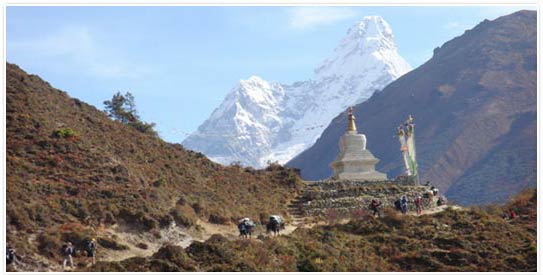|
For over forty years, Nepal has been an extremely fascinating destination
for travelers, scholars, and researchers. For those interested in
culture, the Kathmandu valley, is endowed with seven World Heritage
sites. This valley was divided into three kingdoms less than a century
ago. It now contains countless architectural monuments, and vestiges
of varied cultural and religious traditions.
Kathmandu Valley
This verdant valley was once a huge lake, legend
dictates that in the middle of the lake was a brilliant flame emanating
from a Lotus flower. People would come from miles around to wonder
and worship the flame. A Chinese disciple Bodhisattva Manjushree,
wishing to worship the flame more closely sliced a portion of the
hills with his sword draining its waters and thus the fertile Kathmandu
valley was created.
Chovar gorge where the valley waters drain today
remains the focus of the legend. In the years since, the Kathmandu
valley has seen many dynasties and empires come and go, each leaving
their own mark on the valley's mystique.
The valley today incorporates three major settlements,
all have their own distinctive character with outstanding temples,
works of art and architecture and a varied calendar of feasts and
festivals, their roots in being capital cities of the valleys three
principality's in times gone by. Between them they boast the highest
density of World Heritage Sites to be found anywhere in the World,
seven in total. There are many other fascinating settlements in
the valley offering their own reasons for being there.
The Capital and home to Nepal's only International Airport is a
buzzing vibrant place, although like so many capital cities in the
developing world it begins to show signs of congestion over the
past few years, this hardly detracts from its mystery and celebration
of life. So much history interwoven and sitting strangely in harmony
with the modern Kathmandu. Ancient temples in a medieval atmosphere
sit side by side with Internet cafes. Old blends with new ways…Welcome
to Kathmandu.
Kathmandu Durbar Square - Hanuman
Dhoka Durbar Square is the complex of palaces, courtyards and temples
that are built between the 12th and the 18th centuries by the ancient
Malla Kings of Nepal. It is the social, religious and urban focal
point of the city.
Patan - Patan (The city of beauty) is situated on the southern
bank of the holy river Bagamti (a tributary of the Ganges) some
five kilometers southeast of Kathmandu. Nowadays, it has virtually
become part of sub metropolitan Kathmandu. The city is famed for
its wealth of Buddhist and Hindu temples with an abundance of fine
bronze gateways and wonderful carvings. Patan is known for its expert
craftsmen and metal workers.
Bhaktapur - Is situated 14 km east of Kathmandu and is the
least developed of the three cities in the valley. Translated Bhaktapur
means the city of devotees. The most laid back of the three valley
towns its narrow brick paved streets harbor hidden shrines and statues
around every corner. It is quite easy to spend a whole day here
relaxing and taking in an almost surreal atmosphere. Bhaktapur is
famed for its woodcarvings, pottery and cloth weaving. Many of Bhaktapur's
practices have changed little over the centuries.
| Tours in Nepal |
| » Honeymoon Tour - 8 Days |
| » Sirubari Village Tour - 10 Days |
| » Heritage Tours - 11 days |
| » Nepal Discover- 12 Days |
| » Nepal Tours- 18 Days |
| » Classic Nepal- 20 Days |
NOTE: It is important to keep in mind that the
above programs give only a small and limited reflection about what
is possible!!! More programs and other activities can be designed
along your preferences, by adjusting them in duration, route, combinations
etc. The way you want it, we will design it.
|


